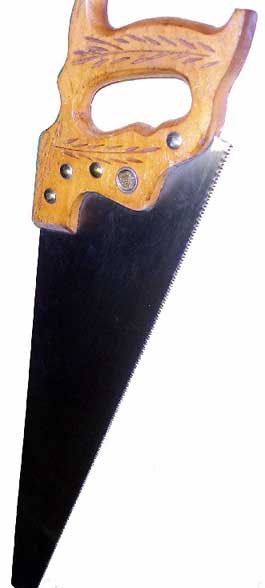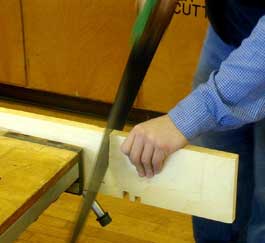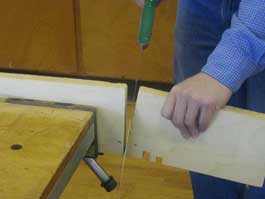Crosscutting with
the Handsaw
|
|
A crosscut saw is designed to cut across the grain of a board. The teeth on a crosscut saw are like a series of sharp knives. This type easily slices through the wood fibers as the saw cuts across the grain. A crosscut saw with large teeth is used for rough work; one with fine teeth is used for finish work. This sheet describes the procedure for crosscutting stock to length. For other operations ask your instructor or refer to one of the many texts available. |
NOTE: Always use caution when handling bladed equipment.
Operation (Crosscutting):
Crosscutting is the operation during which the stock is cut
across the grain to achieve the desired length of the
material; There is a step by procedure identified below
along with illustrations.
-
Select a crosscutting handsaw.
NOTE: A crosscutting handsaw is distinguished by the shape of its teeth. Verify the teeth are arranged to give to rows of points. - Verify the saw is sharp by asking the instructor to check the blade prior to operation.
- Inspect the stock to be crosscut, ensure the stock is clear of any foreign objects that could bind the blade while operating.
-
Lay out a line on the stock using either a Try-square or
a T bevel.
NOTE: Inspect the board, verify which end of the board is going to be scraped. - Once
the line is in the correct location, clamp the stock down
securely. In the event of large stock, use saw horses to
place stock for the cut.
NOTE: Sawing should always be done on or with a solid support to prevent vibration. -
Grasp the saw with your right hand, with the thumb and
index finger extended along the two sides of the
handle.
NOTE: This helps guide the saw in a straight line. -
Stand with your forearm, shoulder and eye follow the line
of the saw blade.
NOTE: In using saw horse, place your knee on the piece to be cut. - With blade on the waste side of the stock, start as close to the line as possible.
- Grasp the edge of the board with your opposite hand, place your thumb, high, on the side of the blade to act as a guide while making the cut.
- Start the saw with two or three light upward strokes; this will engage the teeth.
- Once the teeth are engraved, take a few short strokes to deepen the groove.
-
While removing the left hand, take full length strokes,
applying downward pressure with the arm and body.
NOTE: Applying wrist pressure results in a jerky motion and will create difficulty to follow the line. - If you get off the line, take short strokes, using the teeth at the toe of the blade. Twist the blade slightly to bring the saw back to the line.
- As the end of the cut nears, the operator should grasp the stock with there left hand and take short easy strokes until the saw has completely cut through the work.
Note: There are several other saws that can be operated while using this procedure. Ask your instructor and refer to one of the many references for those procedures.
|
|
|
|
The saw is being held at the correct starting angle, ensuring the blade has penetrated the wood before making full cuts. |
Keep a solid hold of the stock that is not secured in the vice, while maintaining a controlled cut. |
Potential hazards: Due to the sharp teeth on the crosscutting blade the following hazards exist:
- Any body contact with the moving blade will cause severe injury.
- Clothing or other articles that contact the blade while making the cut could become entangled and pull the operator into the motion of the blade.
- Unsecured footing could result in accident with the blade.
- Equipment not in working order can result an injury.
- Distractions from shop personnel could cause injury by misplacement of hands.
Safety practices: Because of those potential hazards the following safety rules must be followed.
- Be sure to perform only operations you know how to do safely.
- Always wear safety glasses.
- Never wear cloths or other articles that dangle and could catch on the saw.
- Be sure to have firm footing.
- Check the saw to make sure it is in good working order.
- Check the stock for foreign objects.
- Avoid distractions, never look away during a cut.
- Do not allow others to crowd around the saw.
- Never let go of the stock during the cut.
References:
Brown & Tustison.(1930). Instructional Units in Hand working. The Bruce Publishing Company. Milwaukee, Wisconsin.
Herman Hjorth, Ewell W.
Fowler. Basic Woodworking Processes. The Bruce
Publishing Company. Milwaukee, Wisconsin
William p. Spence, L.Duane Griffiths,. (1981).
Woodworking (Tools ,Materials, Processes). By:
American Technical Publishers INC.
ITT 252 - Materials Processing
Department of Technology
University of Southern Maine
Prepared by Michael Lapham, 12/01/02


